
by Laura Tiu | Dec 2, 2021
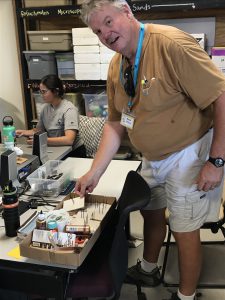
Florida Master Naturalist Student and Florida State Park Ranger, Bruce Williams, prepares for his snowy plover lesson.
There is an oft quoted proverb “those who can’t do, teach.” It is meant to be humorous, but it couldn’t be farther from the truth. Teachers of all kinds have enormous impacts on our lives. For graduates of the Florida Master Naturalist Program (FMNP) there is a line in the mission statement that reads “The FMNP teaches those who teach others about Florida’s unique ecosystems and wildlife.” In fact, to graduate, FMNP students must complete a project and present, or teach, it to the class.
A good teacher, like a good entertainer first must hold his audience’s attention, then he can teach his lesson (John Henrik Clarke). In a recent coastal class, we had the good fortune of having a State Park Ranger as a student. His job requires him to do interpretive education at the park, so he had quite a bit of experience under his belt. His project, a craft project involving the assembly of a cute snowy plover chick, was his way of holding his audience’s attention while he talked of the importance of preserving and protecting habitat for shorebirds.
I thought the project and message was impressive and worthy of sharing. To all of you teachers out there who work to make our lives and world better, thank you, and here is another great activity to add to your quiver. If you would like more information on the Florida Master Naturalist Program go here: https://masternaturalist.ifas.ufl.edu.
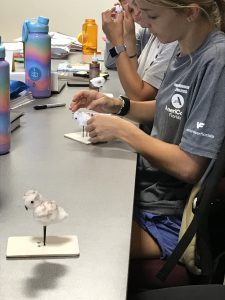
Making cotton ball snowy plover chicks
Group Project: Make a Snowy Plover Chick (Peipert, 2011)
This project is suitable for Elementary age through Middle school age children. It is recommended when doing project with a class or large group that some preparation is done ahead of time.
Supplies:
corrugated cardboard (disassembled brown packing box will do)
1 bag of cotton balls
1 container of black glass beads (sold at craft stores)
black sunflower seeds
1 container of wood toothpicks (kind with one end blunt)
1 can of black spray paint
several of each black, brown & gray markers
several bottles of quick dry tacky glue (sold at craft stores)
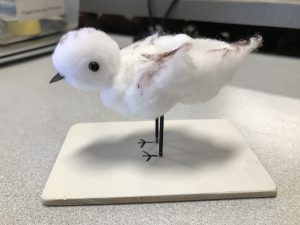
Cotton ball snowy plover chick craft
Preparation:
- Using an exacto or carpet knife and T-square cut corrugated cardboard into 3”x3” squares for the # of stands needed. To complete stand preparation, write Snowy Plover chick on stand, draw a pair of feet in center of stand and pierce cardboard in center of feet. This step is a real time saver and recommended for young children.
- Paint toothpicks with black spray paint for legs, easiest way to do this is by taking toothpicks and sticking them into a spare piece of cardboard upright them paint.
Instructions: (skip to instruction #3 if using stands with feet & holes premade)
- Draw a pair of bird feet on center of cardboard and if you want write” Snowy Plover chick” on cardboard.
- Use the pointed end of a toothpick to make a hole in the center of drawn feet. Then put the blunt end of toothpicks in the holes and put a heavy glob of glue around them. Don’t be shy with the glue, it will dry clear and will be better support.
- Take one of the cotton balls and roll around between hands to make it smaller. This will be the head. Next using all three or two markers make many dots on one side of both cotton balls creating a speckled pattern.
- Put a glob of glue at top of each toothpick and put larger cotton ball (the body) on top of toothpicks pushing down so the glue is covered by the cotton ball. Next put a glob of glue on the top of body and put white side of cotton ball (the head) on glue.
- To complete the chick put a small glob of glue on opposite sides of head then place glass beads on. Lastly put a glob of glue on side of head that the feet are facing forward and place sunflower seed on with the pointed end facing out.
- Let stand for at least 15 minutes to dry before handling.
- Enjoy your Snowy Plover chick creation!
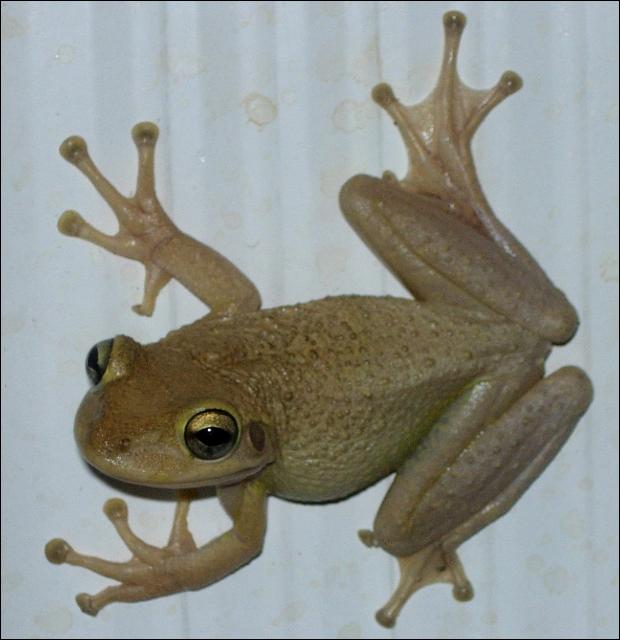
by Rick O'Connor | Sep 30, 2016
Recently I attended a conference that included a series of talks at the University of Florida’s Whitney Marine Lab. One of the talks was presented by the director of the lab, Dr. Mark Martindale, who discussed the history and mission of the lab. However, in that talk he made a comment that caught my attention.
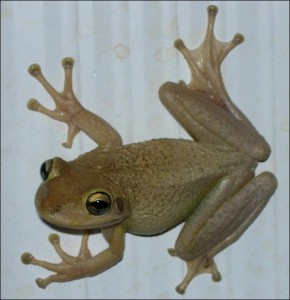
is this a Cuban Tree Frog? Do I have to rely on DNA barconding to know for sure – before I decide to euthanize it? Could I be making a mistake?
Image by Dr. Steve A Johnson 2005.
He was discussing the work of the lab and mentioned the great diversity of microscopic life that existed in the Intracoastal Waterway right out their back door. But while discussing this he also mentioned that today’s biology students identify organisms by DNA markers. Going are the days of collecting the creatures and using taxonomic keys to identify using physical characteristics of the organism. What do I mean by this? Well, the “old timers” would wonder through the woods and shorelines, collecting specimens, and observing their physical characteristics… do they have legs? How many legs do they have? How many antennae do they possess? These “old timers” would observe the natural world, develop taxonomic keys (list of characters to help identify), have them peer reviewed, published, and occasionally updated. New microscopic techniques would alert them to mistakes they may have made and thus corrections and “re-do’s” could be done. There were specialists in this field called taxonomists. If you brought in a seashell, they would be able to identify relatively quickly. If they were confused on a few characters, they would contact their colleagues and an agreement would be reached on the proper identification. And so it went.
Today, this is not needed. The sequencing of genomes of many species have been done. The barcode method of identification by the “new school” is more accurate… as long as the sequence is correct, your identification is correct. There are fewer mistakes. Now problems like identifying what is partially digested in a fish gut can actually be done accurately. In some cases, we are learning that the classic “taxonomic tree” may have some flaws. Creatures whose physical characteristics suggest they are related, may in fact not be. We are looking at the progression of life all over again – it is an exciting time for biologists in many ways. But are we losing something by letting the “old natural history” methods go?
One example I can give is identification of a small marine creature called a lancelot. I was doing a survey of marine life at a local restoration project and collected several of these. I was trained by old school biologists and remembered there were four species of these found in our area. I looked through my old college notes to see if I could find how to tell them apart. I could not find those specific notes. So I thought I would contact local biologists for assistance… no one knew… they suggested I try this… try that… I finally decided that the only one who still knew was my old vertebrate zoology professor, Dr. Herbert Boshung. Unfortunately, Dr. Boshung – like so many other of the “old school” – had passed away.
And there I was… with a creature that I could not identify. The “new school” was not able to help. Could this be happening across the country, across the world. As the “old school” move on and the “new school” move in could we be losing a part of natural history that we won’t be able to get back? This concerned me some. To have people who should know, look at something and say “I do not know what that is” was a little disconcerting. Dr. Martindale thought we may have to “re-discover” all of this knowledge within the “new school” – start again.
I am a marine science educator who is in between the two schools. I was taught and trained by the “old school” – folks like Dr, Boshung and Dr. William Cliburn. I learned a LOT about our natural world through them and have used their “old school” methods to teach my students. The “new school” method of learning about the natural world has made wonderful discoveries and it is exciting to see what corrections will be made and what lionfish are actually eating. But I still feel the loss of the “old school” natural history is a true loss. We in Extension are often asked “can you identify this creature?” Those who have been trained “old school” can – or least to genus. “New school” not so much anymore. They can, but not by looking at it. This just seems to be a part of science education we should hold on to.
There is one place where the non-scientist interested in learning some of the “old school” methods still can… the Florida Master Naturalist Program. This program consists of three modules – uplands, wetlands/freshwater, and coastal. Participants will learn about the natural history and how to identify specific groups of creatures found in these systems – the old school way. For those interested in this I think it is a great program. It is offered through most county extension offices across the panhandle. To find out more about the program, and what modules are being offered in your area, visit http://www.masternaturalist.ifas.ufl.edu/






